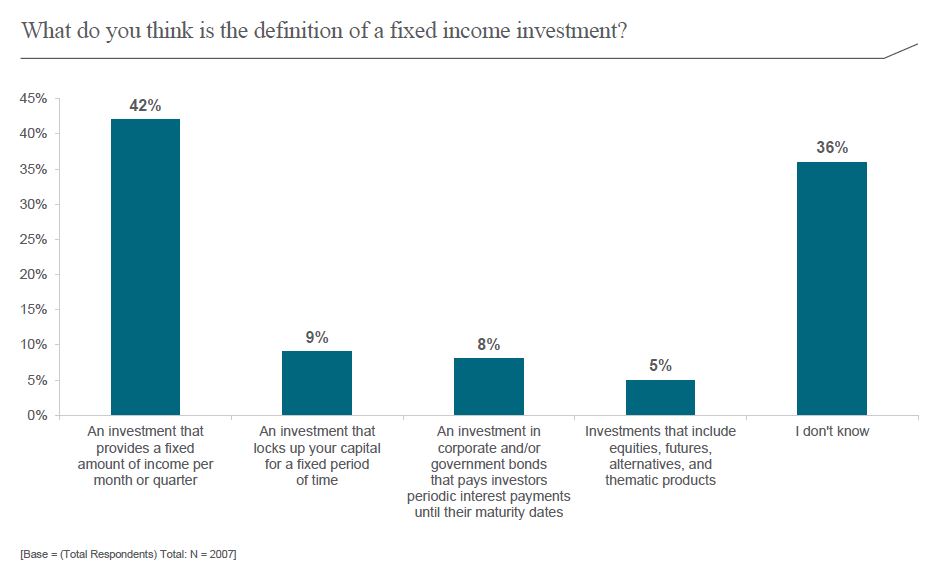(Bloomberg Opinion) -- The top-line takeaway from a BNY Mellon Investment Management national survey on fixed-income investing was stunning: A measly 8% of Americans were able to accurately define fixed-income investments.
The 29-question online survey of just more than 2,000 adults, conducted in July, clearly shows that many Americans admit to having little knowledge about various fixed-income markets and how to invest in them. Here’s a rundown of those who answered “I do not understand it at all” with regard to the following types of bonds: Treasuries, 39%; municipal bonds, 45%; high-yield bonds, 46%; corporate bonds, 51%; structured products, 53%; Treasury Inflation Protected Securities, 63%. Of the 849 respondents who don’t own fixed income or don’t have any investment portfolio, 44% said they don’t buy bonds because they don’t understand the different types of securities.
That’s not particularly heartening to see as someone who writes about all those bond markets, though I can’t say any of those numbers are shocking. Still, it doesn’t quite explain how fewer than one in 10 Americans can correctly define fixed-income investing. It’s one thing to admit you know nothing about subprime auto asset-backed securities or collateralized loan obligations. It’s quite another if you can’t identify a core element of investing, especially considering the definition is practically baked into the name.
After digging into the survey and its questions, it’s clear that 92% of Americans aren’t truly illiterate about the bond market, but it’s also obvious that more investors need a better handle on what fixed income is all about.
So, what is the correct definition of a fixed-income investment, and what were the other options in the survey? Here’s the breakdown:

I’m not disputing that the middle definition, selected by just 8% of respondents, is the “best answer” here. It is. At the same time, I’ve taken my fair share of multiple-choice tests (finance-related and otherwise), and I can spot a tricky question when I see one.
As I said before, fixed-income investing shouldn’t be beyond comprehension given that its core purpose is right there in the name. And yet, while the first two choices in the survey both conspicuously use the word “fixed,” the correct answer substitutes the word “periodic” instead. Again, this is not wrong. But that kind of phrasing, combined with the first two answers having elements of fixed-income investing, sheds some light on that 8% headline figure.
The first answer, which 42% of respondents selected, is admittedly “not bad,” said Gautam Khanna, a senior portfolio manager at Insight Investment, an asset manager under the BNY Mellon umbrella. He wasn’t involved in the survey.
Still, the results show “people generally have a lack of understanding of what fixed income is in the fullest sense,” he said in a phone interview. “Perhaps some people view it as ‘I have money sitting in a CD and that’s my fixed income,’ or ‘I’ve got money sitting in a savings account.’” Those options don’t provide the diversification benefits of owning assets such as Treasuries or high-quality corporate bonds, which tend to gain in price when equities decline, he said.
All of that is true, of course. And yet, I find it hard to outright dismiss almost half of survey participants for selecting an answer that was close, but not quite thorough enough. In fact, the “true or false” segment is perhaps a better indicator that Americans have at least a fundamental understanding of bond investing, even if they’re not quite proficient in certain strategies. A respectable 70% of respondents knew it’s false that “all bonds provide the same level of risk,” and 87% marked as false that “all bonds provide the same level of income.”
Interestingly, BNY Mellon Investment Management highlighted the following answer as an example of the lack of understanding of bond markets: 28% of respondents said it’s true that “fixed income investing is intended only for retirement planning.”
“Fixed income provides some of the most versatile and vibrant investment options available and yet there exists around it a sense of confusion and misperception,” Andy Provencher, head of North American distribution at the money manager, said in a statement. “Chief among these is that fixed income plays an important role solely in the immediate run-up to retirement.”
Yes, fixed-income investments can provide a stabilizing force in a portfolio at any age and a way to mitigate big price swings from riskier assets. But I wouldn’t call those 28% of respondents wildly off base, either. Consider this: BlackRock Inc.’s LifePath Index 2025 fund, which is meant for those retiring in about six years, has a 44% allocation to fixed-income assets. The 2055 fund has just 1.3%. Why is that? Because younger people are typically better off taking more risk and shifting their funds into fixed income as they approach retirement age. That impetus is most likely only stronger when U.S. stock markets have climbed to records while trillions of dollars in bonds around the world yield less than zero.
It’s overstating the case to conclude that the overwhelming majority of Americans are fixed-income illiterate. But with the global bond market growing by the day, it’s clear many of them could use a lesson or two in what role the securities can play in their financial lives.
To contact the author of this story:
Brian Chappatta at [email protected]
To contact the editor responsible for this story:
Daniel Niemi at [email protected]








